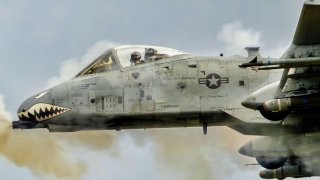Nuclear Warthog: How the A-10 Almost Became a Nuclear Bomber
In 1975, the U.S. Air Force considered the feasibility of arming the A-10 Warthog with nuclear weapons. This theoretical idea would have cost over $86 million in today’s dollars.
Summary and Key Points: In 1975, the U.S. Air Force considered the feasibility of arming the A-10 Warthog with nuclear weapons. This theoretical idea would have cost over $86 million in today’s dollars.
-The concept undermined the A-10’s role as a close air support aircraft, which is designed to fly low and provide tactical support, whereas nuclear weapons are strategic and require high-altitude delivery.
-The weight of nuclear bombs, combined with the A-10's distinctive airframe, made the idea impractical.
-The A-10 also lacked the safety features and capabilities necessary for nuclear operations, making this proposal a fundamentally flawed concept.
A Truly Silly Idea: Arming the A-10 Warthog with Nukes
One of the silliest ideas ever uttered comes from 1975, when the U.S. Air Force did feasibility studies on whether they could make their fleet of A-10 Warthog close air support (CAS) warplanes capable of carrying nuclear bombs. According to a 2015 article at War is Boring, the Air Force surmised it would have cost a total of $15.9 million in 1975 dollars (in 2024 dollars, that’s more than $86 million).
To be clear, this was merely a theoretical exercise.
But at the time of the feasibility study, the Air Force was looking at ways to maintain a tactical air nuclear weapons capability. Rather than simply rely on long-range bombers to maintain the air component of America’s nuclear triad, the Air Force was trying to see if they could augment the capacity by making other warplanes nuclear-capable.
Undermining the Tactical Role of the A-10
For starters, the entire notion undermines what the A-10 is designed for. The Warthog is a tactical warplane meant to hover over a contested battlespace for protracted periods of time, providing close support for friendly forces engaged in combat on the ground below.
Nuclear weapons tend to be strategic systems. So the mission of the A-10 is fundamentally at odds with the mission of nuclear weapons.
Because of its original design as a tactical support aircraft, the A-10 is meant to fly at lower altitudes than most other Air Force aircraft.
These low altitudes are generally below the threshold of what nuclear weapons designers believe to be safe or effective altitudes for operating nuclear weapons. Nuclear weapons delivery usually involves high-altitude drops to maximize the blast radius of the weapon and to minimize the risk to the delivery aircraft from that blast.
But the A-10 does not function as well at higher altitudes as other planes do.
There’s the added issue of weight. A-10s are already heavy birds, what with all their armaments, their 30 mm Gatling gun, and their titanium bathtub cockpit. These birds are heavily armored. Most nuclear weapons are very heavy as well. Plus, the nuclear weapons of 1975, when this concept was first proposed, would have likely exceeded the warplane’s capacity or required significant modifications that might have negatively impacted the A-10’s CAS mission.

Relatedly, the A-10 Warthog’s shape and airframe work against reliably deploying nuclear weapons. The A-10 has a distinctive profile. Its straight wings are meant to carry an abundance of ordnance. The A-10’s design, when paired with nuclear bombs, simply does not work well from an aerodynamic perspective.
Lacking the Necessary Features
The A-10 lacks key features that most nuclear-capable bombers in the U.S. arsenal have. Among its key safety features are hardened storage areas, failsafe mechanisms to prevent accidental detonation, and an advanced suite of electromagnetic warfare capabilities to better protect the operations of the bird while in combat.
The A-10 can take quite a wallop, and it can dish one out, too. But nuclear bombers have a whole different set of capabilities that make them especially primed for conducting nuclear attacks.
Trying to make the A-10 a nuclear bomber would have been foolish. These birds are phenomenal. They are not, however, meant to fight a nuclear war. These planes were meant to keep U.S. and allied ground forces alive in the face of overwhelming threats on the ground.
Author Experience and Expertise: Brandon J. Weichert
Brandon J. Weichert, a National Interest national security analyst, is a former Congressional staffer and geopolitical analyst who is a contributor at The Washington Times, the Asia Times, and The-Pipeline. He is the author of Winning Space: How America Remains a Superpower, Biohacked: China’s Race to Control Life, and The Shadow War: Iran’s Quest for Supremacy. His next book, A Disaster of Our Own Making: How the West Lost Ukraine, is due October 22 from Encounter Books. Weichert can be followed via Twitter @WeTheBrandon.
All images are Creative Commons or Shutterstock.
From the Vault
Russia Freaked Out: Why the U.S. Navy 'Unretired' the Iowa-Class Battleships
Battleship vs. Battlecruiser: Iowa-Class vs. Russia's Kirov-Class (Who Wins?)


